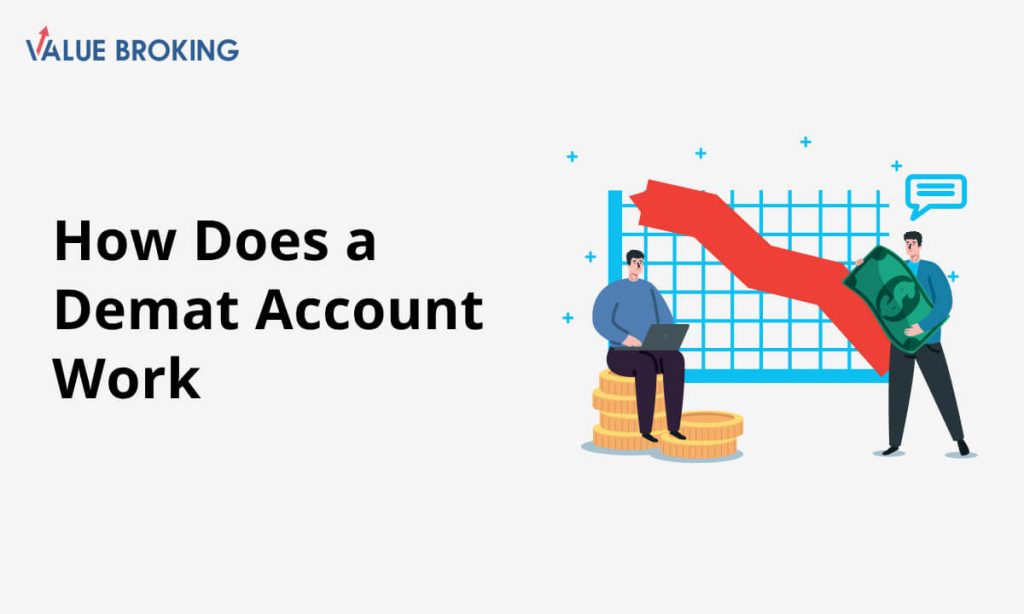How Does A Demat Account Work?

In today’s time, A demat account is now necessary because traditional paper-based securities are no longer used and have been replaced with electronic versions. A demat account, also known as a dematerialized account, is an electronic account that permits and holds digital trading of assets. This article seeks to clarify how a demat account works, how it integrates with trading and savings accounts, how to open a demat account, and how important it is in the financial landscape.
Table of Contents
What is a Demat Account?
Demat account means an electronic repository for holding different financial products, including stocks, bonds, mutual funds, and government securities. By transferring the certificates to electronic or digital form, it does away with the necessity for physical copies. Investors can benefit from ease, efficiency, and safety in trading and maintaining their investments by keeping securities in a dematerialized format.
How Does a Demat Account Work?
A demat account works through a number of different entities and procedures. A detailed explanation of a demat account’s operation is provided below:
Account Creation
A person must go to a registered depository participant (DP), such as a bank, a financial institution, or a brokerage firm, in order to open a demat account. The investor must submit the proper paperwork, which includes a filled-out application form, identity and residence proof, and bank account information.
Dematerialization
The investor can use the dematerialization procedure to change physical securities into electronic form once the demat account is set up. The dematerialization process is started by the investor giving the DP their physical certificates, who then verifies them and sends them to the issuer or registrar. The physical certificates are destroyed after verification, and comparable electronic units are credited to the individual’s demat account.
Trading and Resolution
Investors can trade securities on various stock exchanges using a demat account. The securities are deducted or credited from the investor’s demat account, depending on whether a purchase or sell order is completed. The transaction’s specifics, such as the quantity, cost, and date of settlement, are electronically recorded in the account.
Corporate Behavior
The investor’s demat account is automatically updated in the event of company activities like bonus issues, stock splits, or dividends. For instance, extra shares are credited to the investor’s demat account in the designated ratio if a company announces a bonus issue.
Pledged and Lending
Demat accounts also make it easier for securities to be pledged or lent. Investors can lend their securities to earn extra money or use them as collateral for loans. While the pledged or lent securities are blocked in the demat account, the investor still retains ownership of the securities.
Statements of account activity
Including specifics of transactions, assets, and business actions, are routinely provided by the DP. These statements aid investors in keeping track of their assets and tracking their investments.
Integration of Trading and Savings Accounts
Demat accounts are essential for integrating trading and savings accounts, giving investors a smooth and effective platform. The integration operates as follows:
Linking Bank Account
Investors connect their savings and demat accounts by linking one to the other. This connection makes it simple to transfer money for trading purposes between a savings account and a demat account.
Online Trading
Integrating trading platforms enables investors to transact securities online. From a single interface, investors may place buy and sell orders, keep track of the performance of their portfolios, and get real-time market data.
Automated Settlement
By integrating trading and demat accounts, transactions can be settled automatically. The necessary amounts are automatically deducted or credited to the investor’s account after a deal is completed.
Investment Convenience
Investors can invest easily in initial public offers (IPOs), mutual funds, and other financial products thanks to integration. Instead of dealing with the inconvenience of paper certificates and physical applications, investors can apply for initial public offerings (IPOs) online and receive shares directly in their demat accounts.
Easy Monitoring
Investors may quickly track their investment portfolio and keep tabs on their holdings, transactions, and profits/losses by connecting their trading and savings accounts. This unified view streamlines portfolio management and offers a complete picture of their financial holdings.
The steps involved in opening a demat account are as follows:
Choose a Participant in the Depository
A DP that provides demat account services should be chosen. Think about things like reputation, service caliber, costs, and extra features.
Application Form and Supporting Documents
Obtain the form for opening a demat account from the selected DP. Include any necessary information, such as your name, address, and bank account information. Submit the form together with the required supporting papers, such as a copy of your PAN card, address verification, and proof of identity.
IPV
In-Person Verification complies with the regulatory authorities’ requirement to conduct an in-person verification process. This entails going in person to the DP’s office or other authorised locations to have your identification and documentation verified.
Review the terms and conditions
Read and comprehend the terms and conditions, agreements, and disclosures that the DP has supplied. Sign the required paperwork to show that you have read, understood, and agreed to the terms.
Account Activation
Following the processing and approval of the application, the demat account is activated, and the investor is given a special client ID and demat account number (DP ID). The investor can then begin trading and managing securities using the demat account.
Conclusion
For holding and trading assets in electronic form, a demat account provides a safe and effective platform. Physical certificates are no longer required, trade procedures are made simpler, and it interacts smoothly with trading and savings accounts. The way assets are held and traded in the financial market has been revolutionized by demat accounts, which provide investors ease, transparency, and improved accessibility. It is simple to open a demat account, which enables investors to take advantage of digital securities’ benefits and actively engage in the contemporary financial environment.